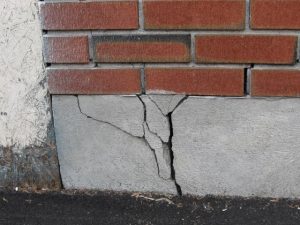 It’s happening, you think you found your dream home. But you noticed a large crack in the foundation, where do you go from here? Foundation cracks can signal foundation problems or just be the house settling. Read below for an introduction to foundation forensics and contact us to schedule an inspection today. Our standard building inspection includes a full structural inspection from roof to foundation, inside and out.
It’s happening, you think you found your dream home. But you noticed a large crack in the foundation, where do you go from here? Foundation cracks can signal foundation problems or just be the house settling. Read below for an introduction to foundation forensics and contact us to schedule an inspection today. Our standard building inspection includes a full structural inspection from roof to foundation, inside and out.
New England homes have many types of foundations including concrete block, brick, and mortared stone, with the most common being poured concrete.
Most basements and garages have four to six inch concrete slabs and, unless this is a slab-on-grade foundation, the slabs are poured independently of the foundation walls. This term is called ‘floating’. Often the construction joint between the slab and wall can easily be seen. A common slab complaint is hairline cracks appearing in spider web-like patterns. These cracks can show up shortly after construction and are normally caused by shrinkage during the curing process. This type of slab cracking is rarely a structural problem because the slab could be completely removed and the foundation walls and columns would maintain a stable building.
Therefore, slab cracking tends to be more of a cosmetic problem. Cracks are often repaired with a variety of grout, caulk, or epoxy products to prevent groundwater penetration, insect entry, and soil gas infiltration. Cracks showing differential movement on opposing surfaces can be a tripping hazard and possibly an indication of serious sub-surface conditions that require further investigation.
The typical problem with concrete foundation walls are vertical hairline cracks. These cracks often start at the top of the wall and travel down to the floor slab. A sub-set of these types of cracks are those that propagate in a diagonal direction from stress concentration points such as the bottom corners of basement window openings. Even when they penetrate the entire thickness of the wall, these types of cracks normally do not constitute a structural problem, as the loads from above pass unobstructed on both sides of the crack to the footings below.
However, when the wall surfaces on both sides of the crack are moving out of plane, or the structure above shows stress in the form of movement or cracking sheetrock walls and ceilings, further structural evaluation is warranted. Foundation cracks should be sealed if periodic water infiltration occurs. Repairing cracks from the outside is often the best method, but due to the excavation costs involved, repairing the crack from the interior by injecting a crack filling material has become a routine solution.
When horizontal wall cracks, multiple closely spaced vertical cracks, or large diagonal cracks in basement corners are observed, these conditions may indicate more serious problems related to settlement or other structural problems. Similarly, a single vertical crack that is much wider at the top of the wall may indicate foundation settlement problems stemming from poor soil conditions, hydro-static groundwater pressures, or frost heaving. These problems should be directed to a knowledgeable consultant.
This can also be applied to concrete block foundation walls, with some exceptions. By their nature, concrete block walls are often not well reinforced and are subject to inward movement from various soil pressures. In addition, ice lens forming about three feet below the ground surface can expand and push concrete block walls inward. When horizontal cracking is observed in block walls, steps should be taken quickly to prevent further movement. These types of walls are also very susceptible to water penetration often requiring serious water proofing repairs.
The key to maintaining a sound brick or concrete block foundation is periodic inspections to ensure loose or dislocated masonry elements are quickly repaired. If you observe a ‘stair step’ pattern crack in the mortar joints of a masonry foundation wall, it typically means settlement has occurred under the ‘step’ section of the wall. Any observed bulges or horizontal movement, as well as new cracks, should be quickly addressed.
Our licensed, Professional Engineers have the skill and experience to diagnose foundation cracks. Contact us today for a free quote!
